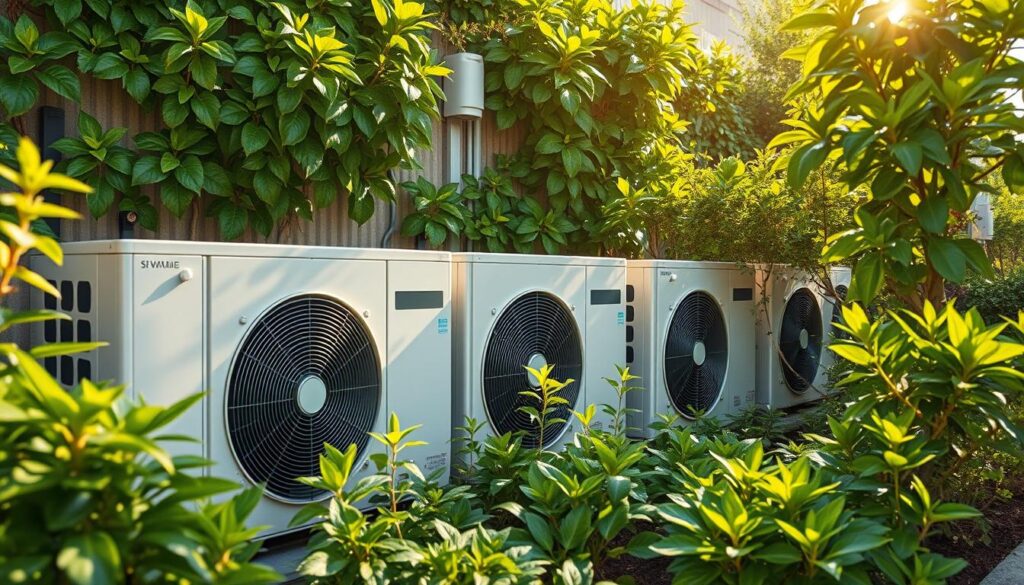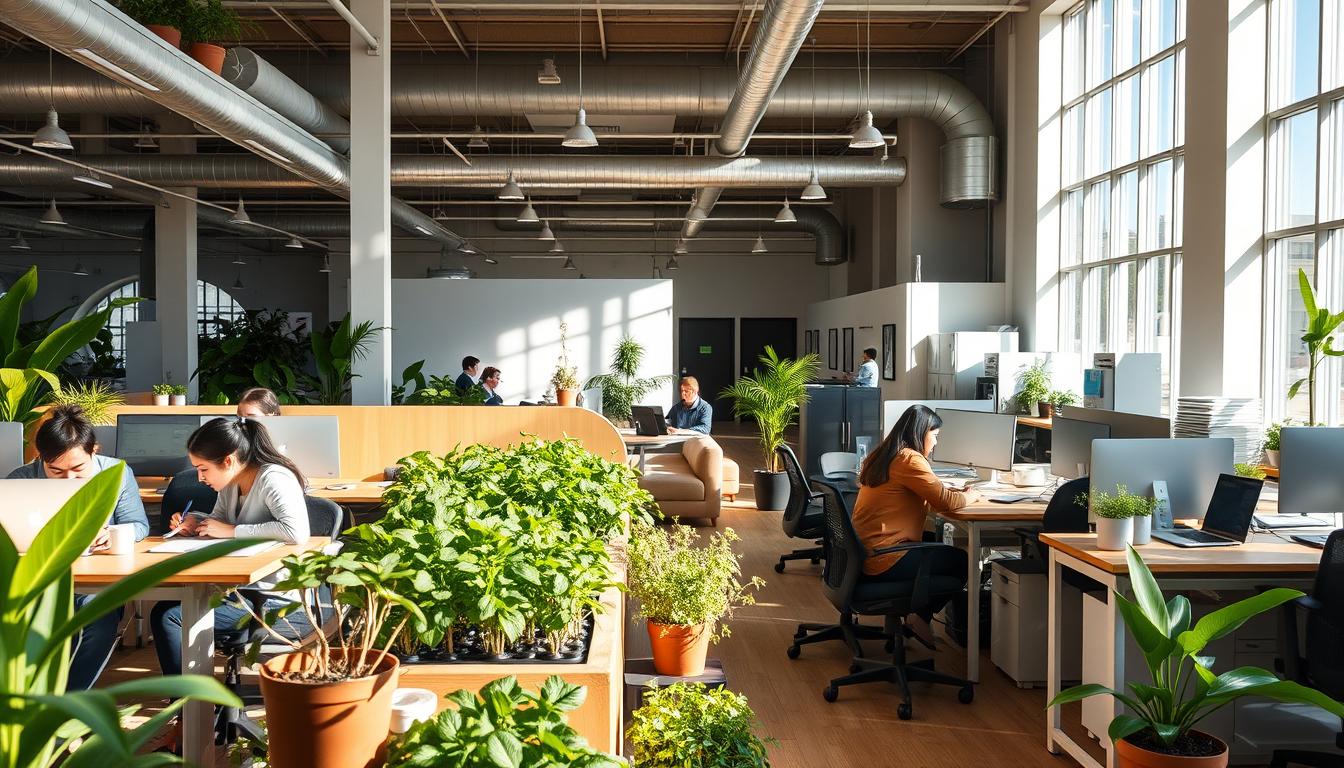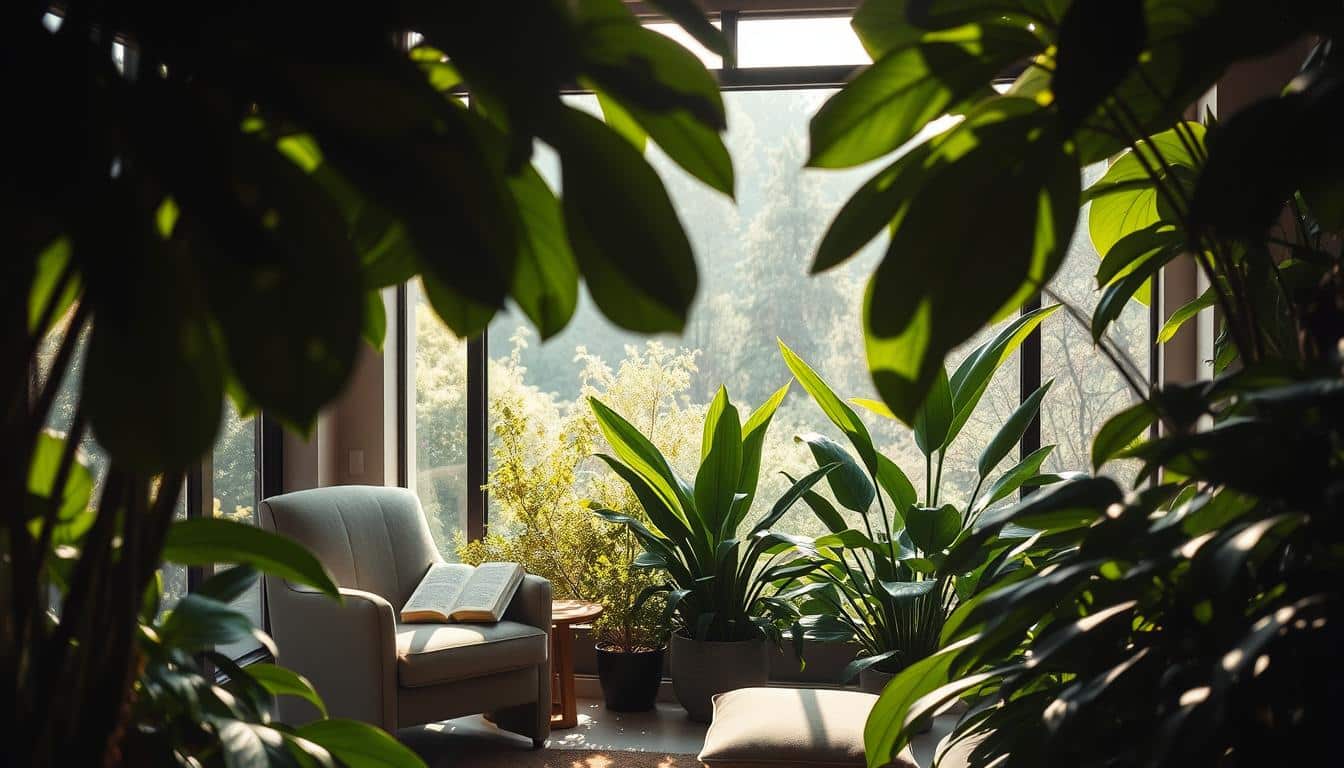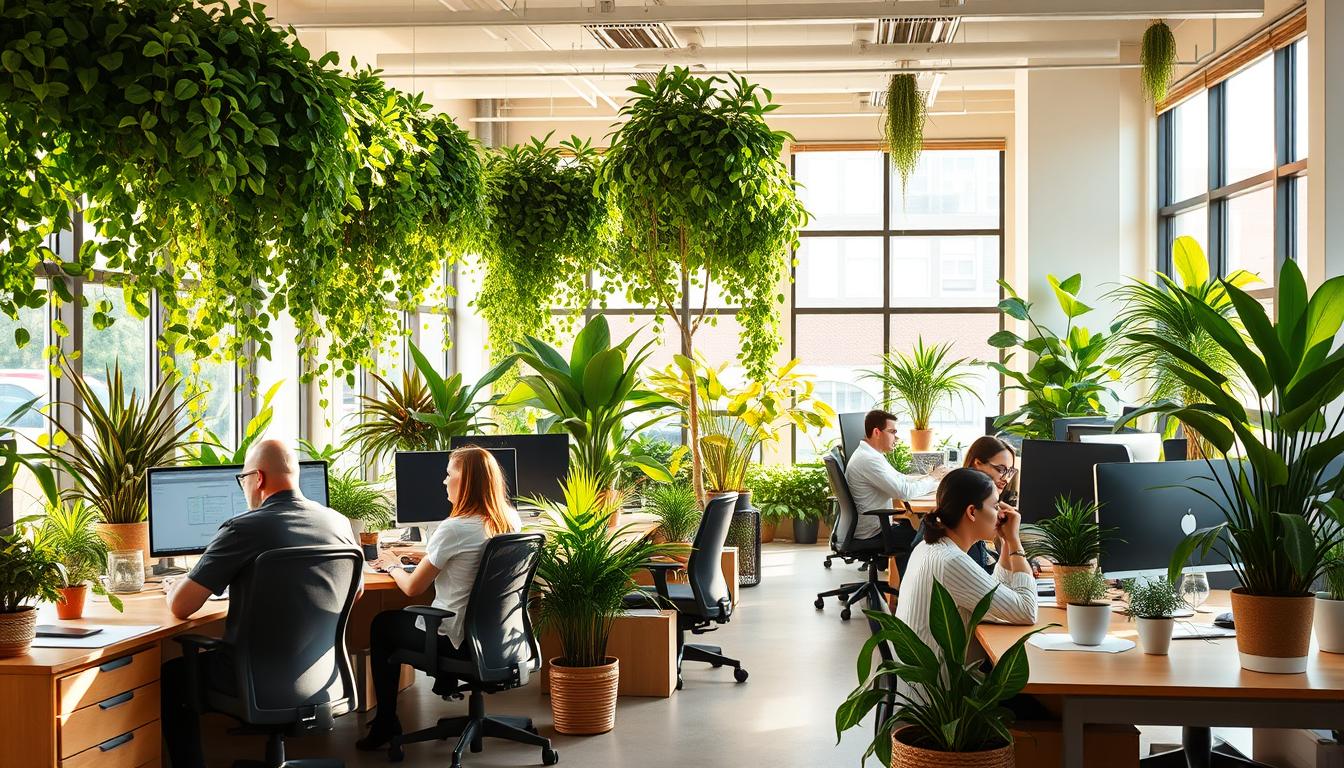Making your HVAC system eco-friendly isn’t just about high-tech gear. It also includes using plants smartly. By adding plants around your home, you can make heating and cooling systems work better and save energy. This method uses nature to boost your HVAC’s performance, cutting down on energy use and improving air quality inside. Knowing how your garden layout affects your HVAC setup is key to living greener and more comfortably.
Understanding Eco-Friendly HVAC Systems
Eco-friendly HVAC systems aim to provide comfort with less harm to the environment. They use new tech to make cooling and heating cleaner and more efficient. A big feature is the smart thermostats. They help control the temperature better and cut down on energy use.
Green tech boosts the effectiveness of HVAC systems. People with these units spend less on energy bills and help the planet. Efficient cooling and top-notch materials contribute to cleaner air inside homes.
Even landscaping helps these eco-friendly systems work better. Plants around the house keep it cooler and use less energy. This shows how eco-friendly HVAC systems improve life quality while caring for our planet.

Benefits of Integrating Plants in HVAC Design
Adding plants to HVAC design brings many benefits beyond looking nice. Plants have a way of keeping rooms warmer or cooler, making our heating and cooling systems work less. This also helps lower the heat island effect, creating a more stable temperature inside. Because of this, we can save energy and cut down on the costs of heating and cooling.
Greenery in HVAC design also helps make the air inside better. Plants are like natural air purifiers, taking out pollutants and improving airflow. This makes our living and working spaces healthier by reducing harmful substances in the air. So, having plants around can make people feel better overall.
Moreover, a landscape with plants makes a property look better. This boost in looks can make a property’s value go up and bring about a sense of pride in the community. In the end, bringing plants into HVAC systems is a smart, sustainable move that offers savings, cleaner air, and beauty.
What are Thermo-Green Spaces?
Thermo-green spaces mix traditional eco-friendly landscaping with modern HVAC systems. This idea uses plants intelligently to make homes more energy-efficient. By selecting the right plants and trees, we can naturally control temperatures and cut down on energy use. This smart landscaping helps homeowners get the most out of their HVAC systems.
These spaces are more than just pretty; they save energy and make heating and cooling systems work better. With careful planning, eco-friendly gardens lead to a greener way of living. Choosing the right plants and placing them wisely can keep your home cool in summer and warm in winter.
Plant-Assisted HVAC Load Reduction
Integrating landscaping into HVAC design is key for energy efficiency. Using natural elements like trees and shrubs boosts an HVAC’s system efficiency. This strategy involves careful planting to support plant-assisted load reduction. It reduces the need for heating and cooling in extreme weather. The right trees and shrubs provide shade, cut wind, and insulate buildings.
The Role of Landscaping in Energy Efficiency
Landscaping isn’t just for looks; it optimizes energy use. Placing plants wisely can cool buildings naturally. This results in less electricity use, lowering bills and helping the planet. Trees block sunlight, and evergreens protect from winter winds.
Types of Plants for Effective Load Reduction
Choosing the right plants is crucial for reducing HVAC loads. Go for native plants; they adjust easily to local climates and need less water. Good choices include:
- Maple trees for their broad canopy and shade
- Evergreen shrubs for year-round wind protection
- Perennials that thrive in local conditions, reducing the need for additional irrigation
Adding these plants into design makes outdoor spaces work harder. They bring cooling effects and boost environmental health.
Native Plants: A Sustainable Landscaping Choice
Using native plants in your garden helps the environment and your HVAC system work better. These plants are perfect for local weather, which means they don’t need much water or food.
Advantages of Choosing Native Flora
Choosing native plants for your garden has many benefits. They are good for the planet and your home. Some key benefits are:
- They need less water, which means you can save on your water bill.
- They’re tough against pests, so you don’t have to use harmful chemicals.
- They help local animals and insects, like bees and butterflies, thrive.
- They make your garden look beautiful with their variety of colors and textures.
How Native Plants Reduce Maintenance Costs
Native plants can cut down your gardening costs. They do well in their hometown climates, needing less fuss than other plants. This makes them a smart choice for an easy-care garden. Here’s how they save you money:
- They don’t need much fertilizer or pesticide, which is better for the soil.
- Using less water means you pay less on your water bill.
- You don’t have to trim or prune them often, saving you time and effort.
Strategic Tree Placement for Temperature Regulation
Putting trees in the right spots is key to managing your home’s temperature. Trees can lower energy bills by providing shade and blocking wind. This means you don’t have to rely so much on heating and cooling systems.
Best Practices for Planting Trees Around Homes
Here are some tips for tree planting around your house:
- Select appropriate species: Choose trees that fit your local weather and soil.
- Consider sun exposure: Plant trees that lose leaves in winter on the south and west sides. This gives shade in summer and lets sunlight through in winter.
- Spacing and placement: Keep trees far enough from your house to prevent damage. Make sure they still protect your home from the sun.
- Evaluate seasonal changes: Pick trees that adapt well to different seasons. They should help with both cooling and heating your home.
- Maintain tree health: Take good care of your trees. Healthy trees are better at saving energy at home.
Enhancing Air Quality through Green Spaces
Green spaces are like natural air purifiers. They absorb bad carbon dioxide and give back fresh oxygen. This makes both outside and inside air healthier. Green areas not only look good but also improve the air we breathe.
Designing landscapes smartly can lower pollutants and allergens. This leads to better health. Adding various plants in cities helps clean the air, supporting air systems to remove toxins. This way, people get to breathe cleaner air and enjoy the beauty of greenery around them.
Noise Reduction through Landscaping Techniques
Landscaping boosts indoor comfort by cutting down noise. Strategic plant placement acts as natural barriers. They soak up and deflect unwanted sounds. This approach reduces noise pollution in homes, making them more comfy.
Plants do more than look good. Dense foliage and big tree canopies block and soften noise. This comes in handy with loud streets or nearby sounds. There are several landscaping tricks to boost these effects:
- Choosing dense shrubs: Thick bushes and shrubs can act as barriers for sound waves, effectively lowering noise levels.
- Planting trees strategically: Trees with wide canopies can create a natural wall, helping to muffle noise from various sources.
- Creating layered landscapes: Combining different types of plants at various heights contributes to a more effective sound barrier.
People in cities or near busy roads really benefit from noise reduction landscaping. Adding plants not just adds beauty. It also lowers noise pollution. This makes indoors more peaceful, fitting well with green HVAC designs.
Increasing Property Value with Eco-Friendly Practices
For homeowners, making your place more eco-friendly is key to raising its worth. People are now paying more attention to sustainability. This means homes with green features like energy-saving systems and eco-friendly yards are more valued.
Having a green outdoor space is vital for making your home look and work better. You can use local plants, smart watering methods, and earth-friendly materials. This makes your yard attractive to buyers and supports a green lifestyle. It also cuts down on cost over time.
Studies show that homes with green features sell quicker than others. People like saving money in the long run with energy-smart homes. So, going green is a wise investment choice, not just a trend.
With more people wanting eco-friendly homes, there’s a great chance for homeowners to boost their property value. By focusing on green upgrades, you can get a better price and help the planet too.
Designing a Sustainable Landscape for HVAC Integration
Creating a landscape that goes well with HVAC systems helps save energy and looks good too. Choosing the right plants is key. Native and plants that don’t need much water are best because they need less care and do well locally.
Using water wisely is also important. Systems that drip water or collect rain are great for keeping plants healthy without wasting water. These green choices improve the landscape and help the HVAC system work better.
Adding surfaces that let rain soak in is smart. It stops too much water from running off and eases the load on drains. Using gravel or special pavers also helps the soil and plants.
To wrap up, when designing a green space for HVAC, think about the plants, how to water them, and the surfaces you use. These steps will make your outdoor space look great, work well, and be kind to the planet.
Conclusion
Summarizing eco-friendly HVAC systems, adding plants improves both energy use and air quality. It also lowers noise. Using greenery in HVAC systems brings many upsides. These include less energy use and higher home values. It makes inside air healthier and saves energy too.
To go green, it’s easy to start by picking plants native to your area. These plants are usually tougher and need less care. Placing trees and bushes smartly can cool your home naturally. This makes your place comfier all year.
Taking up these green practices isn’t just for now; it’s for the future too. By bringing nature into your HVAC, you’re not just improving your house. You’re helping the planet stay green for coming generations.



